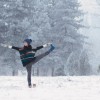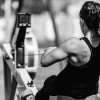Welcome to barn house physiotherapy
Physiotherapy delivers a vast array of treatment techniques which help to restore and improve body movements and functions.
Psychological health is enhanced by physical wellbeing and at barn house physiotherapy the treatment is as individual as you are.
Jacqueline's notes
The Green Gym
It is Chelsea Flower Show this week and the theme is how plants can make you feel healthier and improve people's lives through design. Gardens are the perfect haven to escape from the stresses of everyday life.
The Japanese are familiar with immersing themselves in green by going 'forest bathing' or 'shinrin-yoku' which involves going out into the woodlands and letting go of stress. Apparently essential oils in woods and plants, that they emit to protect themselves, can have a beneficial effect on our immune systems. According to research the stress hormone, cortisol is lowered after a half hour forest visit.
Learning how to breathe effectively can further help to reduce stress. These effective breathing techniques do need practice just like a physical skill. This could eventually lead to a calmer breathing that you can draw upon in times of stress. Exercising in this 'Green Gym' could include some resistance work' push ups on a tree trunk, squats or even pushing that lawnmower!..........so enjoy the benefits that plants and great design have to offer and listen to the attached podcast where I talk about the benefits of gardening. Sponsored by M&G Investments.


get strong to ski but don't forget to breathe
+++++ (Photo Jacqueline Knox © Verbier)
Having just returned from ski-ing in the Swiss Alps it made me realise the importance of breathing, balance and strength when it comes to ski-ing.
Strength
Being strong in our centre/core enables us to be able to balance more effectively and adjust our bodies to those minor unexpected movements that happen on the slopes! The spine naturally rests in its neutral position, neither too arched with the bottom sticking out or too flat with the bottom tucked under. This ‘neutral’ position enables the muscles around the spine and pelvis to work effectively and absorb shock. For ski-ing the weight is shifted slightly forwards over the front of your feet and your core should work naturally to support and stabilise you from underneath. Exercises such as lunges, squats and bridge strengthen the gluteal(bottom) muscles along with the core.
Balance
Proprioception is the body’s awareness of where it is in space (spatial awareness). This spatial awareness is fundamental for when visibility is poor on the slopes. Initially try balancing by just standing still with your eyes closed for 1 minute. Make sure you are safe and have something to grab or hold onto if you feel unsteady. Progress this to standing on one leg with your eyes closed and then progress further to an unstable surface such as a wobble cushion. The more spatial awareness we have, the less likely we are to fall.
Breathing
Using breath to help our movements is fundamental and there is always a tendency to hold our breath when we are anxious and on that steep slope! This year I had really worked on my breathing control and I found breathing into my turns helped my control and stability throughout the turn. Effective breathing not only decreases anxiety but also helps with a more fluid movement so that the general overall movement is more natural.
These 3 things if practised regularly before going ski-ing will help you have more control on those slopes……………………….Have a good ski !


Strength not Length
Strength not Length
As an ex Dancer/Gymnast I have always been flexible. A few years ago (2013) a Conference on Lumbar Spine Pain and Pelvic Pain in Dubai changed my thinking more towards strength. An Australian Physiotherapist presented his research on Strength and Conditioning in Women over 40. Strength training- using your body as a weight or lifting weights could be a game changer for women. Strength training underpins our health and ultimately good form and performance. Since then I have regularly gone to the Matt Robert's Gym in Chelsea and worked out with Richard and Tony on my strength. It has made a huge difference to be able to sprint uphill!
Increasing muscle strength will make a difference to your body definition and cardiovascular training. Strengthening exercises also help to counteract the effects of a slower metabolism and weight gain. So girls...hit the gym or the garden just make sure you are doing some regular resistance training.


triyoga London
I went to triyoga in Chelsea, London last Sunday for a masterclass in yoga for hormones.......
It was amazing. the studio was flooded with light and we spent 2 hours lengthening, strengthening and breathing with flow.......I came out feeling super relaxed and very calm. The idea behind it was to work on the aspects of Yoga that calm the nervous system down, hence why we worked on breathing with flow.
I will be running a masterclass on 'Movement and flow for stress' on Wednesday 20th December where you can learn to do movements that are targeted at relieving stress and calming the nervous system down. Please ring 01780 740242 to reserve your place.
Emily is running some extra drop in Pilates classes in December and early January in order to keep everyone moving who cannot attend regular classes at bh physiotherapy.


October-Make exercise part of your day
October is the perfect time to start a new health kick. A few weeks ago I found myself on a Matt Roberts training day for added motivation to my regime and it was truly inspirational. Since then I have added running up hills into my normal 5k run to get some HIIT (High Intensive Interval training). Walking and running do not have to take hours- the important thing is just to make it part of your day. This week i took a few days off and went up to Northumberland for those fantastic big skies and of course hills! (See photo)If you run regularly then some 30 second sprints up hills will push you into this HIIT zone. On the days that I did not run I made sure that I had a walk before breakfast known as cardio fast, (exercising before eating). The hilly bit gets your heart rate up and pushes you harder so that you end up burning fat for longer. The key thing is just to start slowly and to make walking part of your day and then slowly increase the time and/ or the hill. If you pace yourself and increase your load or distance 10% each week then the body should adapt slowly to this gradual increase in loading. The important thing is to give yourself time to recover at the top of the hill before starting off again. This allows your heart to come back down to near its normal resting pulse. This article is for advice only and if you have any concerns or a history of heart issues then discuss with your GP before starting any new exercise regime. Stop if you feel too breathless, lightheaded or dizzy.


Rowing is the new running
According to recent press releases this week rowing is making a comeback. As a GB Rowing physiotherapist for many years (1999-2008)I can confirm that rowing is a really demanding form of exercise requiring strength, endurance, flexibility in certain muscle groups and a high skill level of co-ordination and balance to do all of this whilst on an unstable surface - water! For me this is what made the sport so interesting and hence why rowers tend to be considered as some of the fittest athletes as it requires this demanding skill set.
The ergo (rowing machine) is a total body workout but like all machines in the gym you need to be shown how to use it properly. Once you have been taught the correct technique it is an effective cardio workout which helps with overall body conditioning and fat loss. The ergo's adaptability means that it can be used for short sprints (HIIT) or long endurance (LISS) depending on your goals, either way it is a tough workout. Make sure you push with your legs rather than pull too much with the arms and use the core for strength. This technique takes some getting use to so remember to start slowly get the technique correct and then build up gradually.
Ergo's can be used as part of an overall fitness training and I regularly use one in the gym when I am doing my strength & conditioning training as a break from weights and to do some quick effective cardiovascular work to maintain my heart beat up in a higher zone for effective training.
Rowing is a fantastic sport for both male and female. Rowing also has a special category known as 'adaptive rowing' for those with physical disabilities.
https://www.britishrowing.org.uk


Just go for a walk
Going for a walk is one of the most powerful and easiest changes you can make to your health and wellbeing. Joanna Hall has developed a training method to teach people to walk naturally using their body efficiently. Her system lengthens and strengthens multiple muscle groups based on posture and technique. To perfect her technique there are 3 levels: Level 1 is technique and posture, Level 2 core and tone and Level 3 pace and fitness. Walking should be relaxed and flowing, too many of us hunch our shoulders, round our spines and thus prevent the natural flowing rotational movement of the spine. Breathing properly is fundamental, by opening up in the shoulders and chest area the breathing becomes more effective. You need to stride out but in a relaxed flowing manner using the bottom muscles to propel you forwards so that your body is active. See Joanna Hall's website for more details ( Walkactive.com)..

Joseph Pilates
Attached is a link to BBC World Service on Joseph Pilates. Initially the method was called 'contrology' as Joseph Pilates worked on very precise 'controlled' movements that strengthened and lengthened the body.He only ever worked on a one to one basis in the studio. This is how I originally learnt pilates in London.


Strength and conditioning
I recently went to a fabulous day of strength & conditioning at Elmhurst School of Dance in Birmingham. The day started really well with a ballet class from Brian Maloney who is Teacher and Rehabilitation Specialist at the Royal Ballet, Covent Garden, London. The beginning at the barre was manageable but that was all as it quickly moved on to push me way out of my comfort zone ! What I noticed was how we all warmed up slowly with movements that became more and more complex involving the whole body followed by stretching. My next class was 'Solutions for supplementary training' which was run by Nico Kolokythas ASCC, Performance Enhancement Coach and PhD researcher at Elmhurst School of Dance. This was strength & conditioning and also hard work. I realised that it is much easier being flexible than strong and my muscles were sore for a few days afterwards as I was not accustomed to working so hard.....evidently room for improvement. Lastly was 'Cardiovascular Training for Dancers' run by Dr Emma Redding, Head of Dance Science & Sonia Rafferty, Senior Lecturer at Trinity Laban,Conservatoire of Music and Dance.Emma and Sonia warmed up up slowly and then we had a vigorous workout bringing our heart rates up to 85% maximum heart rate and then coming back down to 65% heart rate training zone. By the end of which after 90 minutes we were all quite tired!! What we noticed was that as we became more fatigued our co-ordination suffered as a result.
Take home messages from the day were:
1. Ballet is a fantastic way to build up strength & conditioning and starts slowly but builds up to more difficult exercises requiring co-ordination, strength and balance. It is specific and targets weaknesses.
2. Strength & conditioning needs to be part of training as invariably it is the strength aspect that tends to be neglected and yes it is difficult
3. Cardiovascular fitness is key and the fitter you are the less quickly you fatigue which can result in poor co-ordination and injury
We also had lectures by Greg Retter, Clinical Director at The Royal Ballet, Matthew Wyon, Course Leader MSc Dance Science, University of Wolverhampton and Dr Benjamin Rosenblatt, Senior Strength and Conditioning Coach GB Hockey and English Institute of Sport.
So all in all a very informative day and needless to say I was quite tired when I got home.....Jacqueline


Nourish yourself
Movement matters has been a core philosophy of bh physiotherapy from its very beginning in 1996. I must admit that I have been much slower to be mindful of nutrition. The 'French influence' helps to steer me away from processed food but it was not until I visited Jane Clarke in Harley Street that I really began to reflect on why I eat what I eat. Jane Clarke's book 'Nourish' and Amelia Freer's book 'Eat, Nourish, Glow' are full of advice about how we must "nourish" ourselves with good nutrition. It is fundamental to our health just like moving. Both authors advise changing habits slowly as our eating habits are mostly psychological and we need to take baby steps....just like starting to exercise. In summary:If you are eating too much sugar try and avoid the daily drip feed. Start to cut out sugary 'treats' that will actually make you more tired. Be mindful of how much sugar you eat on a daily basis and start by reducing it. Avoid alcohol daily. Try and limit it to two nights per week. If you drink cows milk try and buy organic or try alternatives such as almond, soya and coconut milk. Eat your greens. Similar to exercise, work out what your weaknesses are, strengthen them by giving whatever it is up! According to Amelia Freer we should ' avoid packets and promises' and eat real food. We should buy ingredients not meals. Your health must start with real food and good nutrition. Thanks to Jane Clarke I changed my sugar habit by making purees to add to yoghurt, a simple but effective change. I recommend buying both books. They will both help to change your eating habits and start your journey on the way to better nutrition and better health. This article is for interest and advice only as I am a physiotherapist not a nutritionist. Both authors are qualified nutritionists.


Gardeners Question Time Radio 4
BBC Radio 4 Gardener’s Question Time : Exercise
This accompanies an interview for Gardeners Question Time. March 2014
Any transformation that happens in the body happens in the mind first. Make exercise part of your day, like brushing your teeth. Preferably 35 minutes a day (no more than 75) with a days rest. When I lived in Australia exercise was pretty fundamental to life, people ran, cycled home from work , sometimes even stopping off on the way home from work to have a windsurf!
There are basically 4 types of exercise that we need to be doing : cardiovascular exercise : the type of exercise that gets the heart rate up (Karnoven formula 220-age ) and gets you sweating. Brisk walking, raking leaves, pushing lawnmower, running. Resistance exercise : weights or own body weight , strengthens muscles and helps to increase bone density. This could include lifting, pushing and pulling, weeding. Flexibility ( Stretching ) : lengthening tight and shortened muscles : releasing tight muscles post work out. Neuromotor (Mind / body programming ): brain train exercises. Improving mind / body co-ordination, control and fine motor control. Potting things up, planting, dead heading and pilates, t’ai chi & yoga on the lawn. Relates also to mindfulness and breathing . Gardening can combine all 4 !
Warming up
This is imperative to get your brain into gear that you are going to be exercising, start gently with some warming up movements. This also helps to avoid stress and strain and gets the body switching on the appropriate muscles to do the tasks ahead.
This could involve arm openings, squats, bridging , exercises to switch on the deep muscles that support the spine. These are warming up exercises for gardening. Movement exercises. Stretching comes later once the muscles are warm and can then lengthen after having using them.
HIIT (High intensity interval training)
Short, sharp, shock. Gardening is perfect for this, shovelling , digging, takes a few minutes at full pelt.
Stretching
Stretching tight muscles comes after exercise. Part of warming down. When I was working for GB Rowing I remember sprinting fast to the finish line when out for my run. The physiologist (Al) working with me asked me why I did that and suggested that I warm down for 10 minutes to get rid of lactic acid ( a waste product in the muscles from exercising) by fast walking and then slow walking and rehydrating at the same time. Thanks to him I was no longer stiff the next day or the day after.
Doms
Doms stands for delayed onset of muscle soreness. It is the pain and stiffness felt in muscles several hours to days after unaccustomed or strenuous exercise. The soreness is felt most strongly 24-72 hours after exercise . It is thought to be caused by eccentric ( lengthening) exercise, which causes microtrauma to the muscle fibers. . After exercise the muscle adapts to prevent muscle damage. The soreness is a dull aching pain in the muscle often combined with tenderness and stiffness. The soreness usually peaks 24 -72 hours post exercise, thus it is known for the day after the day after that. The mechanism behind it is thought to be microtrauma to the muscle fibers. There is also thought to be a chemical reaction, which in turns causes inflammation and pain due to the accumulation of prostoglandins, histamines and potassium.
Soreness is not such a bad thing . Elite athletes suffer from DOMS most of the time. They decrease its effects with ice baths etc. DOMS can be reduced or prevented by gradually increasing the intensity of the new exercise programme. (Difficult for gardeners when the weather is nice and you want to get going). My advice is then to vary the activities so that you are using different muscle groups. Proper nutrition to manage electrolytes and glycogen before and after exertion can help to ease soreness. Start with a good breakfast…..
Muscle balancing / injury prevention
Sadly our lifestyle today offers sustained static posture hunched over a desk or in a car and repetition of the same tasks. This can lead to an imbalance of muscles, sometimes being much stronger on one side of the body than the other . Obviously hand dominance naturally leads to this. However if one group of muscles becomes over dominant they then have a tendency to exert different forces on joints. Today the medical professionals call this ‘muscle balancing’ so that the forces are equal and opposite. These opposing forces help to keep a joint stable and support it. When gardening this can also be brought about by varying the tasks eg mowing the lawn , potting up, weeding, raking. Pacing yourself. Remaining hydrated all key to help avoiding injury.
Breathing
Normally we would not give this a second thought ! Its automatic . However due to lifestyle factors most of us have lost the ability to breathe effectively. Basically bad breathing involves using the upper chest and sometimes neck muscles and taking short shallow breaths through your mouth. Good breathing involves breathing in through your nose lightly so that the air travels deep into the base of the lungs and out through your mouth. Good breathing improves the circulatory system, strengthens the nervous system and helps to mobilise the ribs and thoracic spine thus enabling relaxation. A perfect end to a day in the garden.
Mindfullness
With all the gadgetry of today we have lost the ability to just be, to daydream , to be in the moment. The garden is the perfect place for this. Switch off the phone, sit up straight and listen to the sounds within your own body: your breathing, your heartbeat. Do not nod off! Remain focused. Sit with intention and bring mindfulness to your breathing. Thoughts will bubble up to the surface, lists of things to do, frustrations, anxieties but this is all normal. Continue with it and in time you will learn to let the thoughts go and you will feel the mind and body slowing down as they enter a tranquil stillness. You are basically teaching your body to come out of its sympathetic nervous system drive of fight flight and going into the parasympathetic nervous system of rest and digest. The background maintenance of the body.
Pilates, Yoga , Feldenkrais are all perfect for this and can be done on the lawn in bare feet , thus heightening the nervous system sensory input. Concentrating on the moves and breathing releases mental pressure and calms the mind.
Eating
The best way to lose body fat is to detoxify your diet by eating as organically and locally as possible, preferably your own garden. Cut out the processed foods. Lose the toxins lose the fat.
Depression
Exercise is the single intervention with the best proof of its effect on mental health, including positive emotions, depression, anxiety, cognitive processing….Physical activity is a stellar method to promote well being. The thing with gardening is that it is a win win situation with actually achieving a goal at the end of it. What’s not to like…….

bh products
bh oils are designed for the clinic by aromatherapist Lady Lesley Addison using only natural ingredients
more >

How barn house can help you
Sports injuries and other conditions such as:
ARTHRITIS
NECK RELATED HEADACHE
BACK PAIN
SCIATICA
SHOULDER PAIN
LOCKED JOINTS
BACK PAIN DURING PREGNANCY
WHIPLASH INJURIES
NECK PAIN
PAIN & STIFFNESS POST FRACTURE
PAIN & STIFFNESS POST ORTHOPAEDIC SURGERY
SOME TYPES OF INCONTINENCE
can be treated by physiotherapy...
more >
barn house books
Body control pilates manual
This is the complete colour, illustrated guide to total well being the Body Control Pilates way.
more >
Pilates Pregnancy Guide
A unique programme packed with good advice on how to keep you healthy and toned throughout your pregnancy.
more >

Garden your way to health and fitness
Pilates principles are at the heart of the step by step sequences that illustrate the safe way to carry out everyday tasks in the garden
more >








